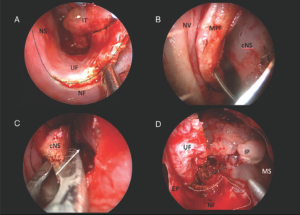Introduction
A range of open and endoscopic approaches to the maxillary sinus have been described and used for the treatment of both rhinological and skull base disease. Endoscopic approaches to the maxillary sinus have largely replaced open techniques, but in selected scenarios open approaches are still necessary (J Laryngol Otol. 2020;134:473–480).
Explore This Issue
August 2022While a wide variety of pathologies of the maxillary sinus, pterygopalatine, and infratemporal fossa can be addressed through an ipsilateral or an open approach, contralateral approaches are useful for lesions seated laterally, anteriorly, and inferiorly in the coronal plane. Expanded approaches to these anatomical areas include the Caldwell-Luc, mega-antrostomy, medial maxillectomy, Denker’s, prelacrimal Denker’s, and transseptal. A transseptal approach enables improved access to challenging anatomical locations, particularly pathology seated in the anterior and lateral regions (Am J Rhinol Allergy. 2009;23:426–432). However, access maybe be limited by the height of the nasal floor and there is an increased risk of septal perforation (J Laryngol Otol. 2020;134:473–480). Septal perforation symptoms can vary depending on the size and the location of the defect; however, they include epistaxis, nasal obstruction, crusting, nasal discharge, cacosmia, and intermittent whistling, and have a negative impact on a patient’s quality of life. They can be difficult to manage and are a risk associated with any septoplasty. This article describes a transseptal approach by elevating bilateral mucoperichondrial flaps and approaching a lesion from the contralateral side, which offers an expanded window to the maxillary sinus. Additionally, we also demonstrate our technique for septal reconstruction after this approach.
Method
A 40-year-old African American male presented to an outside facility with a six-month history of nasal obstruction. In-office biopsy reported a nasal polyp, and he was scheduled to undergo middle meatal antrostomy, septoplasty, and inferior turbinate reduction. Intraoperatively, he was found to have an inverted papilloma. His surgery was then aborted, and he was referred to Augusta University Medical Center for further management. The patient was scheduled for a transseptal approach to the maxillary sinus and pterygopalatine fossa with septoplasty.

Figure 1. (A) Incision and elevation of “U”-shaped mucoperichondrial flap; the dotted line marks the area of incision. (B) Contralateral side mucoperichondrial flap sutured to the lateral nasal wall. (C) Removal of septal cartilage; the white arrow shows the transseptal window where the scope will pass. (D) Transseptal window showing exposure; the white dotted line marks the area where the “U”-shaped flap was raised. cNS = cartilaginous nasal septum; IP = inverted papilloma; IT = inferior turbinate; MPF = mucoperichondrial flap; MS = maxillary sinus; NF = nasal floor; NS = nasal septum; NV = nasal vestibule; UF = “U”-shaped flap.